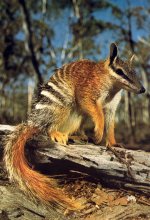 The Numbat (Myrmecobius fasciatus) lives in the Southern and Western parts of Australia. Before the English name of the Myrmecobius fasciatus was changed to 'Numbat', its common name was the "Banded Anteater". This was a misnomer, because the Numbat primarily feeds on termites.. It synchronizes its day with termite activity which is temperature dependent. The Numbat hunts on the termites by waiting until they become active and when they do it uses its excellent smell to determine specialized galleries just below the surface on the way to the feeding sites of the termites. It then uses its claws to get to the termites. The Numbat cannot do any harm to the termite mound, because it only has little claws, unlike for example pangolins. In the 1970's, the population of numbats on Australia declined to about a 1000 animals, by the deliberate release of the Red fox on Australia. Its conservation status is still 'vulnerable'.
The Numbat (Myrmecobius fasciatus) lives in the Southern and Western parts of Australia. Before the English name of the Myrmecobius fasciatus was changed to 'Numbat', its common name was the "Banded Anteater". This was a misnomer, because the Numbat primarily feeds on termites.. It synchronizes its day with termite activity which is temperature dependent. The Numbat hunts on the termites by waiting until they become active and when they do it uses its excellent smell to determine specialized galleries just below the surface on the way to the feeding sites of the termites. It then uses its claws to get to the termites. The Numbat cannot do any harm to the termite mound, because it only has little claws, unlike for example pangolins. In the 1970's, the population of numbats on Australia declined to about a 1000 animals, by the deliberate release of the Red fox on Australia. Its conservation status is still 'vulnerable'.
The Banded anteater, numbat is listed as Vulnerable (VU), considered to be facing a high risk of extinction in the wild, on the IUCN Red List of Threatened Species
Namings for the numbat
A young / baby of a numbat is called a 'pup'. A numbat group is called a 'colony or cloud'.Countries
AustraliaSome facts about the
Numbat
Adult weight : 0.472 kg (1.0384 lbs)
Maximum longevity : 11 years
Weaning : 243 days
Litter size : 4
Basal metabolic rate : 1 W
Body mass : 0.438 kg (0.9636 lbs)
Temperature : 32.85 °C (91.13 °F)

Custom Search